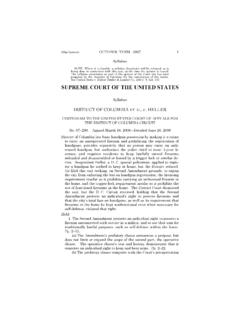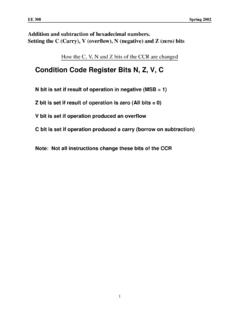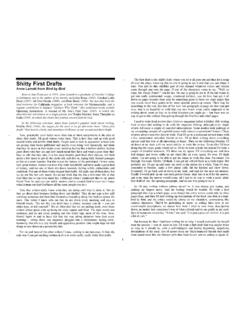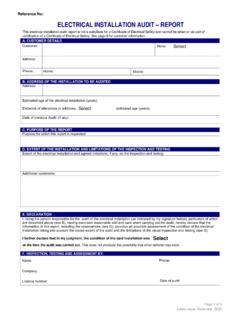Transcription of Science Georgia Standards of Excellence Fourth Grade …
1 Science Georgia Standards of Excellence Georgia Department of Education March 31, 2016 Page 1 of 4 Fourth Grade Standards The Science Georgia Standards of Excellence are designed to provide foundational knowledge and skills for all students to develop proficiency in Science . The Project 2061 s Benchmarks for Science Literacy and the follow up work, A Framework for K-12 Science Education were used as the core of the Standards to determine appropriate content and process skills for students. The Science Georgia Standards of Excellence focus on a limited number of core disciplinary ideas and crosscutting concepts which build from Kindergarten to high school. The Standards are written with the core knowledge to be mastered integrated with the Science and engineering practices needed to engage in scientific inquiry and engineering design.
2 Crosscutting concepts are used to make connections across different Science disciplines. The Science Georgia Standards of Excellence drive instruction. Hands-on, student-centered, and inquiry-based approaches should be the emphasis of instruction. The Standards are a required minimum set of expectations that show proficiency in Science . However, instruction can extend beyond these minimum expectations to meet student needs. At the same time, these Standards set a maximum expectation on what will be assessed by the Georgia Milestones Assessment System. Science consists of a way of thinking and investigating, as well a growing body of knowledge about the natural world. To become literate in Science , students need to possess sufficient understanding of fundamental Science content knowledge, the ability to engage in the Science and engineering practices, and to use scientific and technological information correctly.
3 Technology should be infused into the curriculum and the safety of the student should always be foremost in instruction. The Fourth Grade Georgia Standards of Excellence for Science engage students in constructing meaningful models that allow them to gain understanding of the natural world. They speculate about observations they make. They add, subtract, multiply and divide whole numbers on paper, mentally, and with calculators. They list common materials for making simple mechanical constructions and for repairing things. Fourth graders gather and interpret data and use records, tables, or graphs to identify patterns of change. They write instructions and make sketches that allow others to carry out a scientific investigation. They determine whether or not a comparison is fair if conditions are different for each thing being compared.
4 They question claims or statements made by people outside their field of expertise. The students will use these skills to compare and contrast the physical attributes of stars and planets, model the effects of the relative motion of the Earth and moon around the sun, use weather charts/maps to predict weather events, conduct investigations about the water cycle and understand their relationship with heat energy, communicate information about the nature of light and sound, study the effects of balanced and unbalanced forces on an object, and describe the flow of energy in an ecosystem and the roles organisms play in a community. Science Georgia Standards of Excellence Georgia Department of Education March 31, 2016 Page 2 of 4 Earth and Space Science S4E1. Obtain, evaluate, and communicate information to compare and contrast the physical attributes of stars and planets.
5 A. Ask questions to compare and contrast technological advances that have changed the amount and type of information on distant objects in the sky. b. Construct an argument on why some stars (including the Earth s sun) appear to be larger or brighter than others. (Clarification statement: Differences are limited to distance and size, not age or stage of evolution.) c. Construct an explanation of the differences between stars and planets. d. Evaluate strengths and limitations of models of our solar system in describing relative size, order, appearance and composition of planets and the sun. (Clarification statement: Composition of planets is limited to rocky vs. gaseous.) S4E2. Obtain, evaluate, and communicate information to model the effects of the position and motion of the Earth and the moon in relation to the sun as observed from the Earth.
6 A. Develop a model to support an explanation of why the length of day and night change throughout the year. b. Develop a model based on observations to describe the repeating pattern of the phases of the moon (new, crescent, quarter, gibbous, and full). c. Construct an explanation of how the Earth s orbit, with its consistent tilt, affects seasonal changes. S4E3. Obtain, evaluate, and communicate information to demonstrate the water cycle. a. Plan and carry out investigations to observe the flow of energy in water as it changes states from solid (ice) to liquid (water) to gas (water vapor) and changes from gas to liquid to solid. b. Develop models to illustrate multiple pathways water may take during the water cycle (evaporation, condensation, and precipitation).
7 (Clarification statement: Students should understand that the water cycle does not follow a single pathway.) S4E4. Obtain, evaluate, and communicate information to predict weather events and infer weather patterns using weather charts/maps and collected weather data. a. Construct an explanation of how weather instruments (thermometer, rain gauge, barometer, wind vane, and anemometer) are used in gathering weather data and making forecasts. b. Interpret data from weather maps, including fronts (warm, cold, and stationary), temperature, pressure, and precipitation to make an informed prediction about tomorrow s weather. c. Ask questions and use observations of cloud types (cirrus, stratus, and cumulus) and data of weather conditions to predict weather events. d. Construct an explanation based on research to communicate the difference between weather and climate.
8 Science Georgia Standards of Excellence Georgia Department of Education March 31, 2016 Page 3 of 4 Physical Science S4P1. Obtain, evaluate, and communicate information about the nature of light and how light interacts with objects. a. Plan and carry out investigations to observe and record how light interacts with various materials to classify them as opaque, transparent, or translucent. b. Plan and carry out investigations to describe the path light travels from a light source to a mirror and how it is reflected by the mirror using different angles. c. Plan and carry out an investigation utilizing everyday materials to explore examples of when light is refracted. (Clarification statement: Everyday materials could include prisms, eyeglasses, and a glass of water.)
9 S4P2. Obtain, evaluate, and communicate information about how sound is produced and changed and how sound and/or light can be used to communicate. a. Plan and carry out an investigation utilizing everyday objects to produce sound and predict the effects of changing the strength or speed of vibrations. b. Design and construct a device to communicate across a distance using light and/or sound. S4P3. Obtain, evaluate, and communicate information about the relationship between balanced and unbalanced forces. a. Plan and carry out an investigation on the effects of balanced and unbalanced forces on an object and communicate the results. b. Construct an argument to support the claim that gravitational force affects the motion of an object. c. Ask questions to identify and explain the uses of simple machines (lever, pulley, wedge, inclined plane, wheel and axle, and screw) and how forces are changed when simple machines are used to complete tasks.
10 (Clarification statement: The use of mathematical formulas is not expected.) Life Science S4L1. Obtain, evaluate, and communicate information about the roles of organisms and the flow of energy within an ecosystem. a. Develop a model to describe the roles of producers, consumers, and decomposers in a community. (Clarification statement: Students are not expected to identify the different types of consumers herbivores, carnivores, omnivores and scavengers.) b. Develop simple models to illustrate the flow of energy through a food web/food chain beginning with sunlight and including producers, consumers, and decomposers. Science Georgia Standards of Excellence Georgia Department of Education March 31, 2016 Page 4 of 4 c. Design a scenario to demonstrate the effect of a change on an ecosystem.
















